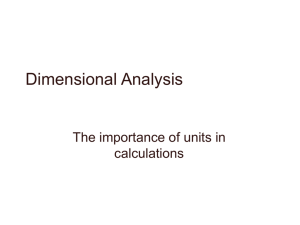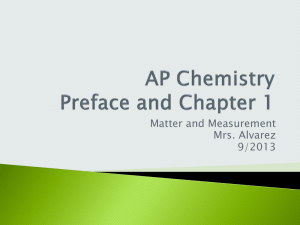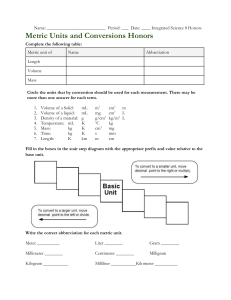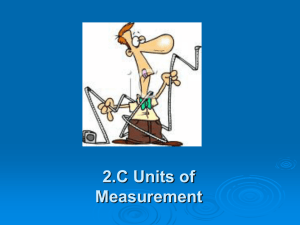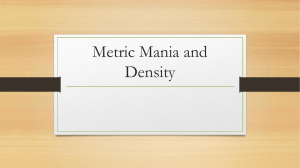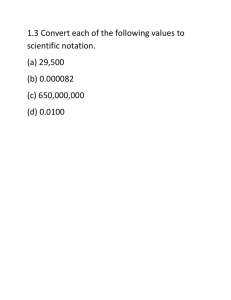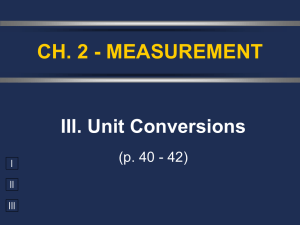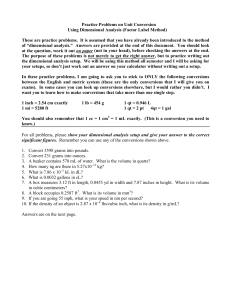AP Chemistry Preface and Chapter 1
advertisement
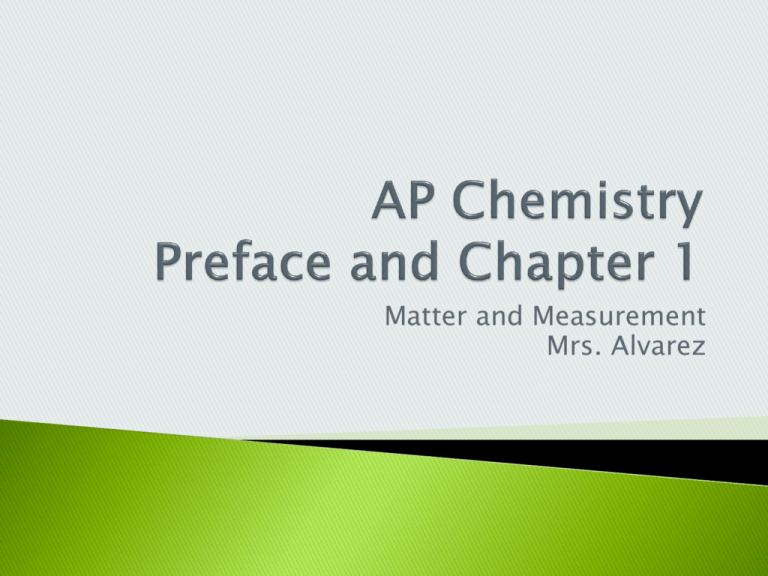
Matter and Measurement Mrs. Alvarez Definition: Mass per unit volume of a substance Formula: D = m/V ; units: g/mL, g/cm3, kg/L Sample Problem A piece of copper has a mass of 57.54 g. It is 9.36 cm long, 7.23 cm wide, and 0.95 mm thick. Calculate density (g/cm3). 2. Use of density as a conversion factor: Sample Problem: Mercury (Hg) has a density of 13.6 g/cm3. What is the mass of 95 mL of Hg in grams? In pounds? First, note that 1 cm3 = 1 mL Strategy 1.Use density as a conversion factor to calculate mass (g) from volume. 2.Convert mass (g) to mass (lb) Need to know conversion factor; 454 g = 1 lb Density of water changes with temperature – why? Intensive property - is a physical property of matter that does not depend on the system size or the amount of material in the system Examples: density, color hardness, melting point, boiling point Extensive property – any property that depends on the size of the system. A property that changes as the amount of matter changes. Examples: mass, volume, temperature, energy released/absorbed State of matter: gas, liquid, solid Kinetic Molecular Theory: A theory of the behavior of matter at the molecular level Kinetic Energy: The energy of a moving object, dependent on its mass and velocity K.E. = 1/2mv2 Matter has both _______ and _________ Macroscopic –measurable and observable to the naked eye Macroscopic properties - color, length Submicroscopic or particulate –not measurable with a microscope Particle size, chemical bond length 3 examples 2 forms of energy Is energy a form of matter A. Measurement Systems – Definition and use of SI (metric) system Metric: English: B. Prefixes (see page 25 in textbook) also on white board Measurement System – in summer work C. Length base unit – meter Conversions: 2.54 cm = 1 inch D. Mass ◦ base unit – kilogram Conversions: 453.5 g = 1 pound (only on earth!) E. Time base unit – second Conversions: 1 hour = 60 minutes; 1 minute= 60 seconds (NOTE THESE ARE EXACT NUMBERS) A value that is calculated from other measured values; not directly measured ◦ Volume – L x W x H G. A problem solving method Definition: used to convert one or more units to other units ◦ Example: how many seconds in a day ?? ◦ 1 day 24 hours 1 day 60 min 1 hour 60 sec = 1 min A. Express the quantity 1.00 ft in different dimensions (inches, meters). 100 cm = 1m 454 g = 1 lb Exact and don’t impact significant figures Simple conversion: How many cm3 in 2.57 L? How many inches are equal to 4.00km? A speed of 80. km/hr is equivalent to how many inches per minute? 150.0km2 = ? mm2 Convert 3.50 g/km3 to kg/m3 Accurate – close to the true value Precision – reproducibility of the measurement Percent Error: Numbers in math Vs. Numbers in chemistry State the problem ◦ Organize the information ◦ Determine what you know & what you need to know Determine the strategy ◦ May stem from prior knowledge Write down each step ◦ NO WORK NO CREDIT!! Check your answer ◦ Is it reasonable???? Chapter 1 ◦ ◦ ◦ ◦ ◦ Density p. 39 # 21, 23, 25, 55, 57 Unit Conversions p. 40 31, 33, 35, 37, 53, 59 Problem solving p. 40 45, 47, 49, 61, 63, 77 Dimensional Analysis Worksheets Sig fig review worksheet

